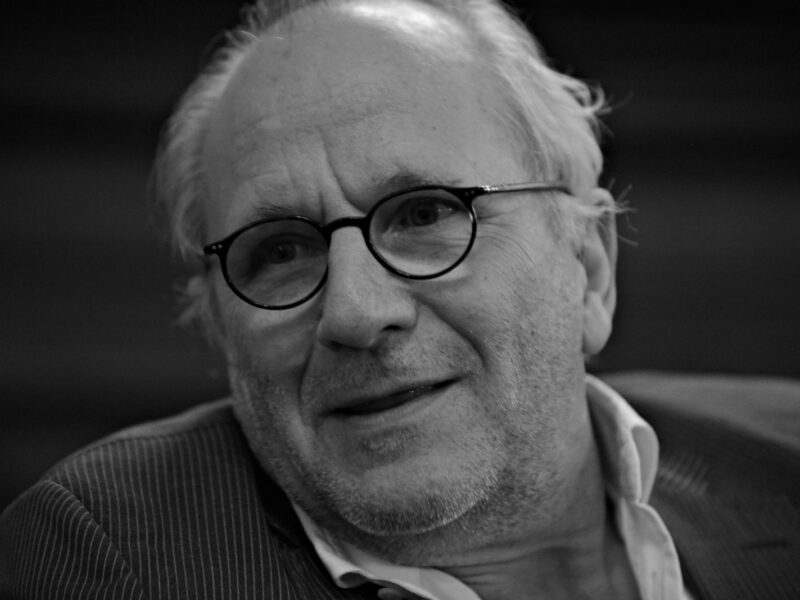Dulce María Zúñiga is the director of the FIL Prize for Literature in Romance Languages, awarded annually at the International Book Fair in Guadalajara, Mexico. She is also the coordinator of the Department of Cultural Studies at the University of Guadalajara and of the "Julio Cortázar" Latin American Department and the "Primo Levi" Humanities Department. She is a translator from French, Italian and Portuguese. She holds a PhD in Italian literature from the University Paul Valéry in Montpellier (France) and has published six studies of comparative literature, including El tedio, el suicidio y la luna (Instituto de Cultura Culiacán) and La novela infinita de Italo Calvino, (FONCA-Tierra Adentro). In May 2023 she was in Romania to attend the ceremony honouring Mircea Cărtărescu, winner of the FIL Prize in 2022, hosted by the Cervantes Institute in Bucharest.
How was the FIL Prize for Literature in Romance Languages born? I know that it was originally named after Juan Rulfo and was limited to Latin American and Caribbean literature. How did it get to its current form, covering all Romance languages?
The prize was born in 1991 thanks to an organisation made up of public and private entities: banks (such as the National Bank of Mexico, the Promex Bank - which no longer exists), the University of Guadalajara, the National Council for Culture and the Arts and others. There were 40 public and private institutions that came together in an association to give a literary prize to a writer from the region, Ibero-American; that is, from Spain, Portugal, all of Latin America and the Caribbean. That's why it was originally called the Juan Rulfo Prize for Latin American and Caribbean Literature and consisted of $100,000. Every year in Guadalajara, a series of literary critics meet (in the beginning there were nine) and discuss the candidates, the writers eligible for the prize. It's a prize that follows a literary trajectory. It's not about a single book, it's about a lifetime of dedication to literature. The first to win it was Nicanor Parra, the great poet who lived for more than a hundred years.
It worked this way until 2015, when there was a disagreement with Juan Rulfo's family. In fact, with the Juan Rulfo Foundation, the heirs of the great writer born in the state of Jalisco in Mexico. This misunderstanding started with a writer who received the Prize, Tomás Segovia, a Spanish poet who lived for many years in Mexico and collaborated with Vueltamagazine, , which was run by Octavio Paz, the great Mexican author and poet, who at some point distanced himself from Juan Rulfo. These are the details. But Tomás Segovia said that Juan Rulfo was "a miracle". And the family interpreted that as saying he was an uncultured person. No one understood how it came to this, but a complaint was filed. The family forced us to withdraw the name, we had to go to court, because we had the right to use the name, which Rulfo's widow had signed over to us for a hundred years. The Association won the case in 2017, but it was decided that we would eventually stop using the name, so that we wouldn't have this discussion every year. Because there was more talk about this conflict with the family than about the writer laureate.
It was then decided to call it the FIL Prize for Literature in Romance Languages. The linguistic and geographical scope was widened, the prize was increased from $100,000 to $150,000, so that it could also be open to Italian, French and Romanian writers (two Romanians won). This is the history of the prize. But more important are the names of the thirty-two prize-winning writers, all of exceptional quality.
Is there a permanent or annual jury? Long lists, short lists? How are the winners chosen?
There is a seven-person jury, which changes annually. No more than 30% of the members can remain the following year. And they cannot participate for more than two years. For example: last year the jury included Professor Oana Sabo, who was on the jury the year before. So, this year she can't participate. Professor Carmen Mușat also participated twice, so she can't either. In this way, the jury is renewed every year, but there is also continuity, with 2-3 members who can repeat every two years. These seven decide the winner.
The nominations are received on the Guadalajara International Book Fair website. It is a form that must be filled in with information about the bibliography of the proposed writer and translations of his or her work, so as to give as complete a profile as possible. Proposals can be made by publishers, teachers, book clubs, writers' associations, etc. We receive around 120 applications a year. From these, the jury selects three finalists based on names and CVs alone. They don't read the candidates' texts. Then they discuss the twenty-one finalists (twenty-one at most, because there are always overlaps) in Guadalajara. And from these they announce a winner. No special prizes, just one winner. And the names of the other candidates remain secret.
Is it necessary that these writers nominated for the prize are already translated into Spanish?
In Spanish or other Romance languages. The most important thing is that they are writers who go beyond their language, their country of origin, their environment. They must be internationally known writers. That's the case for all those who have won this prize: they have been translated; they are studied. It's an international prize, so they have to be very open. So, writers like Mircea Cărtărescu are awarded.
Apart from the prestige the prize brings to the winners, it also has an important financial value, as you have already mentioned. How do you manage to get this money?
The association is supported by institutions that donate every year to provide the money for the prize itself, but also for the organisational infrastructure behind it: so that the laureate can travel to Guadalajara, for example, or so that I can be here in Bucharest, where the prize awarded to Cărtărescu will be presented. All these expenses are covered. Every year, we, the organisers, meet and discuss what has been spent, and the donors continue to contribute. And they contribute huge amounts. That way the prize has continuity. Otherwise, it's very difficult.

What effects does the prize have on the winners' work and career?
I think that being part of the International Book Fair gives the award a huge media platform. The fair is attended by hundreds of journalists from all over the world and thousands of readers, not only from Mexico but also from the United States, for example - librarians, teachers, people from the publishing world. And we know that after the prize is announced, the books are reprinted and sell very well or sell translation rights in other languages. For example, we know for a fact that Diamela Eltit's books have sold much better than before the prize. Others, for example, after winning the FIL Prize, have also won the Cervantes Prize, such as Juan Gelman or the Venezuelan writer Rafael Cadenas. The same goes for Fernando del Paso. I don't know if it's a coincidence, but I'm sure the FIL Prize catapults them into the international spotlight. The winners are talked about a lot, they are interviewed and become more and more famous. That's what happened, for example, with Ida Vitale, it was like a springboard.
Norman Manea is the other Romanian winner of the prize. His texts, like those of Mircea Cărtărescu, are imbued with local historical, cultural and geographical references. How do Mexican readers, for example, understand or decipher these references? Can they become familiar with them?
I think so. There are many common contacts. Norman Manea's book, for example, The Return of the Hooligan, is perfectly readable by a Mexican. The atmosphere of danger, of oppression is also present in Mexico.
Now?
Yes, this tension, not necessarily political, that has built up because of the strength of the drug business is very strong. We feel it all around us. The same atmosphere of oppression, of pain, of fear that we find in Norman Manea's literature. The same with Cărtărescu's references - it's magical realism, isn't it? It's a literature that can speak our language. Just as in Romania you can read the work of Juan Rulfo. The names of people or villages may not be familiar to readers, but the feeling of death, of the meaninglessness of life, of wandering through desolate lands is universal. When it is good, literature resonates with many readers.
What does the Mexican book market look like now, with all the inflation and financial challenges, with all the "narco" terror you speak of?
It survived the pandemic years, which were very tough, when digital competition won the game, we all turned to electronic devices. In 2020 the fair didn't happen, but the industry held on. It seems to me a living industry, because last year, in 2022, many Mexican publishers attended FIL, sold, did business. There are, of course, the big Spanish publishing groups, which have swallowed up many of the growing Mexican publishers; when they have a good catalogue and seem to be doing well, they get bought. That's what happened with Sexto Piso, with Almadía, which were founded by very intelligent and enterprising young people and have now been bought out. There is constant and very strong literary activity. On the other hand, there are the government-owned publishing houses, like Fondo de Cultura Economica, which have a policy "of their own". But there are many others. Grupo Planeta is very strong in Mexico, Anagrama too. It sells a lot. So does Siruela. Spanish publishers are very present. And they bring works of world literature.
As in many other territories, I suppose there are big differences between the big publishing groups you mentioned and independent publishers. Are there still independent Mexican publishers? And how do they manage to survive?
Yes, there still are, but it's very difficult for them. And they can cope by having good catalogues, publishing good quality writers. And there are many writers who choose to publish with these smaller publishers. For example, that's how Sexto Piso came about. I witnessed the episode when they managed to get the rights to Claudio Magris, the Italian writer who had won the FIL Prize that year. They offered to publish him, but said they didn't have the money. And Magris said "never mind". So he gave them a book of stories and they published it. It was an exceptional case. But there are effervescent independent publishers who publish a lot of short texts, poetry, short stories, rarely do they publish novels. There are many such initiatives. Unfortunately, many of them grow as they grow and then disappear. Or they grow, succeed and are bought.
I should mention that during the FIL International Fair, in another part of Guadalajara there is "La Otra FIL" / The Other FIL. It is a fair made by independent publishers. Because they say "we can't pay to attend FIL", but we are here. They meet, they present their books, they invite their authors, it's like a mirror of the international fair, which is much stronger in many ways. The other fair is like an association of independent publishers who can't afford the big fair, but want to promote literature in one way or another.
So the Mexican book industry is alive, it's in very good shape.
What is the relationship between translations and local/national literature?
There are few translations done in Mexico. Almost all the translations we read in Mexico are made in Spain. Or some in Argentina. But little by little, Mexican translators are gaining ground. Because that's a shame. There are over a hundred million of us Mexicans and we have to read in a language that looks like ours, but is not ours. For example, I translate from Italian into Spanish. By a miracle for which I will always be forever grateful, they asked me to translate Italo Calvino into Spanish for Siruela [Spanish publisher, editor’s note]. And so three books by Calvino were translated into Spanish by a Mexican translator. For me it's a personal success, but it's also a success for Mexican translators in general. We have to get out of the circle of the university environment we are in or of the independent publishing houses and get out there [in Spain, to the big publishing groups, which have distribution in all the Spanish-speaking territories, editor’s note].

How does a translation done by a Spanish translator differ from one done by a Mexican translator?
For example, when I translated Italo Calvino, I did not use "vosotros" for second person plural addresses. Because in Latin America it is not used. We say "ustedes". But I didn't use "ustedes" either. I tried to avoid using these pronouns as much as possible. So a Spaniard will not encounter either "vosotros" or "ustedes". I found a way to construct the sentences so that I don't use them. It was hard, but I succeeded, and Siruela accepted the translation.
As you are also the coordinator of the Cultural Studies Department at the University of Guadalajara, how interested do you think students are in Romance literature on the one hand, and the book industry in Mexico on the other.
There is a lot of interest in literature written in other languages. Unfortunately, there are no modern literature studies in our university at the moment. Only Mexican literature. There is a master's degree in Mexican literature, a bachelor's program in literature, so there is no French, Italian, Romanian literature. Not even comparative literature studies. And it's a pity, because students are very interested. At one time, I gave some courses in French and Italian literature and they were interested. I think the next generation of academics will have to found European studies or comparative literature programmes. To create this openness to other cultural spaces.
The second most spoken language in Mexico is English. But that limits us. We should start studying other languages, as you do. To have access to other literatures.
Are there study programmes dedicated to the book industry?
No, in our university, which is very big, there are four hundred thousand students, there are no such studies. Only in librarianship, in literature, in communication, but not something specifically for the publishing area. But there are at universities in Mexico City.
[Photo Dulce María Zúñiga: FIL/BERNARDO DE NIZ]
[Interview audio recorded in Spanish and transcribed and translated into Romanian.] [Translated into English by Oana Dragomir.]



